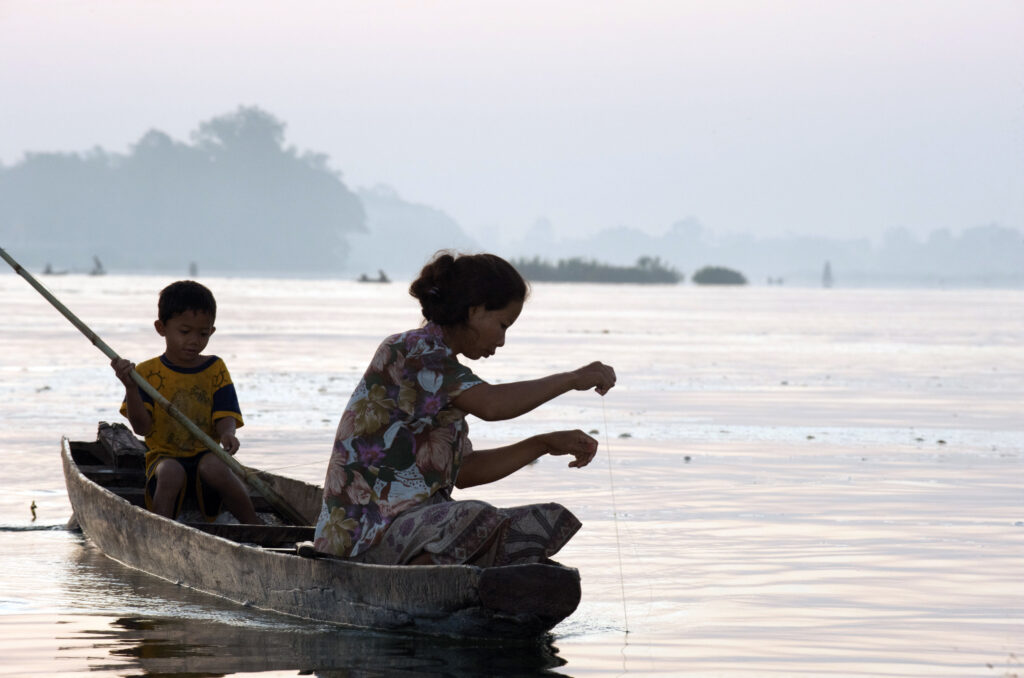By Matthew McCartney and Mark Dubois

Fish have been integral to the people of southeast Asia for millennia. The fishery of the Mekong River is believed to be the largest freshwater fishery on the planet. In 2012, more than 2.3 million tonnes of fish were caught with an estimated monetary value of USD 11 billion. In reality, the fishery of the Mekong is priceless for the millions of people, many earning less than USD 2 a day, who depend on it for their livelihoods, food security and health.
Sadly, this huge and diverse fishery, is now in serious trouble. This is the stark conclusion of a just published WWF report: The Mekong’s Forgotten Fishes, that IWMI reviewed and endorses. Nearly 20% of the 1,148 species present in the basin are close to extinction and commercial fish catches have declined dramatically in recent years. Fish populations in the Tone Sap Lake have collapsed by 88% and, elsewhere in the river, fishers are struggling to secure a catch.
Occurring over just a few decades, the change has been rapid. Reasons for this calamity are well known: ecosystem degradation, habitat loss, sand mining, water pollution, hydropower and irrigation dams, and water diversions are the main causes, all exacerbated by climate change. For too long, fisheries in the Mekong have been overlooked and ignored in the rush for economic development.
The impact of agriculture on Mekong fisheries
Expanding agriculture is one of the main causes of habitat loss. Rice paddies have expanded throughout the Tonle Sap. In the Srepok, Sesan and Sekong Rivers (major tributaries of the Mekong in Cambodia, Lao PDR and Viet Nam), 19% of primary forest was lost between 1992 and 2017, with more floodplain forest (31%) lost than upland forest (18%).
In the lower Mekong Basin, there are approximately 15 million hectares of agricultural land, much of which is for rice. In recent years, irrigation has also expanded, now covering 4 million hectares and abstracting 12% of the mean annual river flow.
Agriculture typically undermines fisheries. Use of chemical fertilizers and pesticides pollutes waters and can kill fish if applied inappropriately. Construction of irrigation infrastructure (i.e dams, dikes and weirs) alters river flow, thereby modifying riverine and floodplain habitats. Infrastructure also blocks fish migration – an important part of the lifecycle of many Mekong fish – preventing breeding and spawning.
In the Mekong Delta, agricultural intensification programs, including dike construction to prevent seasonal inundation, have increased rice production, but household consumption of fish and other aquatic animals has reduced significantly, with poor households experiencing the greatest loss. Poor and unempowered fishers pay the price of agricultural development, often without reaping any of the benefits.
Navigating the trade-offs
Better integration of fish in agricultural landscapes, including irrigation systems, can bring both financial and nutritional benefits for rural communities. However, a key challenge to incorporating fisheries in agricultural systems is that fisheries are diffused across scales and systems, leaving them badly documented and accounted for. There is rarely any integrated landscape planning that incorporates fisheries within the broader context of land and water management. As the title of the WWF report makes clear, fish are usually forgotten.
As a contribution to making fish more “visible”, IWMI and WorldFish, and other partners have developed two important tools: a practical guide to help water planners, managers and engineers integrate fisheries in irrigation systems; and a decision support system to help target investments by identifying locations in rice-landscapes most suitable for integrated agriculture and fisheries production systems. What is needed now is to convince landscape planners, engineers and financers of irrigation and, more broadly, water infrastructure to use these tools.
There are many potential advantages to better integrating fisheries in agricultural landscapes. If freshwaters can be governed and managed to sustain fish, many other societal goals – on biodiversity, nutrient and carbon cycles, recreation, water quality, access, inclusivity – can also be achieved. Although there are inevitably trade-offs, the reality is that protecting and enhancing fisheries can often be achieved at relatively minor cost. As the WWF report makes clear, what is good for fish is also good for people and good for the planet.
Now is the time to factor the fishes of the Mekong into decisions about the basin. The vitality of the mighty river depends on them and if lost, not only the people of the Mekong, but the whole world will be impoverished.

